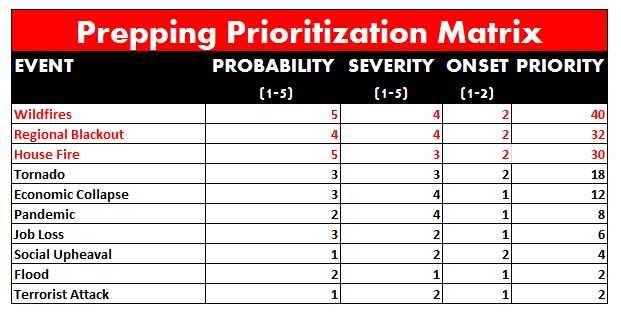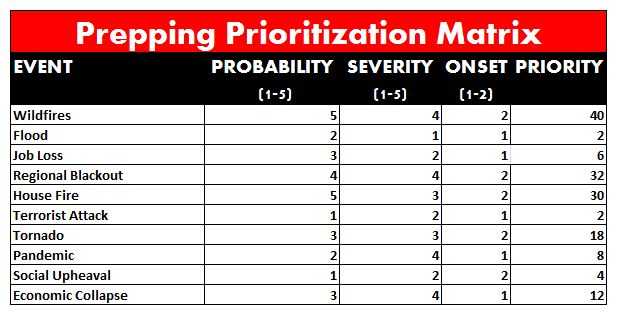This is a good article, especially for someone starting out.
https://www.survivopedia.com/why-you-need-to-be-prepping-only-for-this-scenario/
https://www.survivopedia.com/why-you-need-to-be-prepping-only-for-this-scenario/
Why You Need To Be Prepping Only For This Scenario…
GENERAL PREP, Survival Skills
By
Bob Rodgers
December 9, 2019
Lately, we see a lot of people trying to prepare as best as they can for whatever SHTF scenario they envision.
However, the main question for which they always have to figure out an answer is, “ What should I first prepare for?”
Unfortunately, the answer to this question is never easy, and not only beginners have to figure it out, but also advanced, more experienced preppers. Read forward, and I guarantee that this article will provide some clarity and help you decide what you should prepare for.
Over the years, I’ve helped people prepare and also provided some tips and suggestions that I’ve successfully applied to my prepping plans. However, I always tell my readers that the insights provided may not always work for their particular cases.
Over and over, people ask me the same questions “What do you think we should prepare for?”. Even though they provide me with details about their condition, I’m always telling them to do a threat analysis before they start prepping. The model I’ve been using has helped many people, and I want to share it with as many preppers as I possibly can.
The life of a new prepper
In 90% of the cases, people that start to prepare are told that there are dozens of things they need to buy and that they should do it as soon as possible to make sure they have the proper stuff when the brown stuff hits the fan.
Things like having a bug out bag, a large stock of food and water to last for a few months, and building an armory or whatever in their basement are the most common bits of advice. To the new preppers all of these are overwhelming and confusing, and unfortunately most of them will give up since they can’t wrap their heads around all of it.
Even for the rest of us, oftentimes we have to decide what to do first based on the budget we have and the available time to invest in our prepping plans. The sad part is that most people will toss a coin in the air and let lady luck tell them what to do.
For the determined prepper, there is a better, simpler way to start with all of this. In fact, this technique is used by decision-makers to analyze risk and decide what order they should follow. It’s not a big, hushed up secret, and it is called prioritization.
If you think about it, you are doing this every day of your like, and you prioritize your action based on the situation you have to deal with. Even when you pay your bills you have to prioritize, and you will take care of those who need to be addressed first when you are working with a limited budget. Of course rent and electricity will have priority over food or new clothes.
How to make a threat analysis
Almost ten years ago, I learned a prioritization model when attending a productivity training with the company I was working with. That knowledge stayed with me, and I’ve adapted it to my changing lifestyle.
Ever since then, I developed the habit of dividing my working time into four different quadrants (Q1-Q4). I’ve realized that by doing so, I can help myself to categorize tasks and focus on what is the most urgent and important.
For example, here is how you would apply this if you have a desk job:
Q1
These are the important and urgent tasks you need to take care of. Maybe there is a crisis with an unsatisfied client, or maybe you have a pressing deadline. These are the type of tasks that cannot be finished if you don’t have a risk management plan. For these tasks, you spend most of the time trying to reduce the damage or figure out a temporary solution.
Q2
These are important but not urgent tasks. The things you often do during a normal working day. Things like planning a project, identifying or preventing a project blocker, networking and so on. These require most of your time and concentration, and overall, these are the tasks that increase productivity.
Q3
These are urgent but not important tasks. Here we can categorize the interruptions we have to deal with due to colleagues or other various reasons. Also, the long (boring) meetings that could have been replaced by a proper lined-out mass email are a perfect example of this categorization. Think of these as the tasks that slow down your productivity or mess up your work schedule.
Q4
Here we have the not urgent and not important tasks. Often called long breaks, these include the time-wasters such as Social media, long coffee breaks and everything that bites a big chunk of time from your working schedule.
The same principles listed above were applied in my case when I started prepping. I realized that I have to determine and decide on what is the most important reason for me to start prepping. Over the years, I’ve optimized this threat analysis to be more coherent, as you will see below.
Most folks fail to realize that the most urgent task may not be the biggest task when it comes to prepping, and relatively small tasks may need to be completed before anything else. This is why you need to know how a threat analysis works and learn to make one.
Understanding the formula for building a threat analysis
Every manager, regardless of the field he or she may be working in, uses two main factors when it comes to evaluate and prioritize risks and actions. These factors are probability and severity.
The probability factor calculates how likely it is for something to occur, and the severity factor established the magnitude of the impact if that “something” occurs. These two components are a good start, but a prepper will need a third factor to figure out what to prepare for.
In our case, the third factor is onset, which covers the lead time, if any, you may have to prepare for the SHTF event.
If you assign a numerical value to these factors, you can calculate a number that will help you establish the priority for said SHTF event. For example, if you live in California and you have to decide if you should prepare for wildfires or for a pandemic. You will likely pick the wildfires over the pandemic.
While the severity can be just as bad for both SHTF events and can happen without a prior warning, history has shown us that wildfires have a much higher chance of occurring than a pandemic.
To keep it simple here is the formula you should be using when deciding what to prepare for:



















































